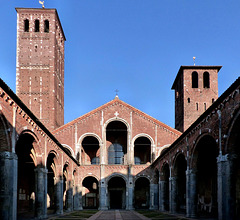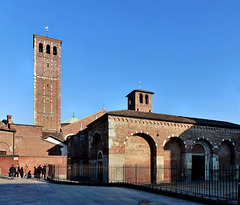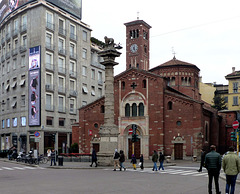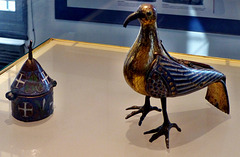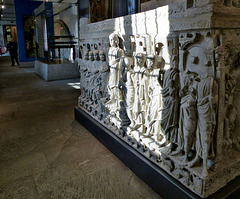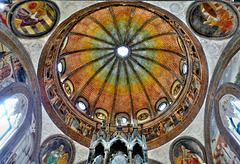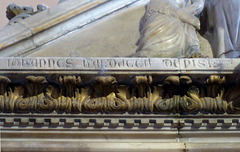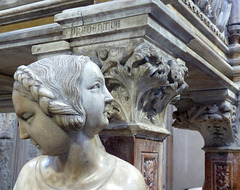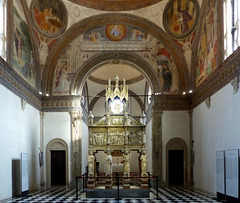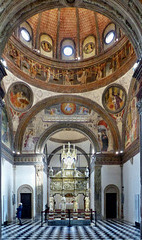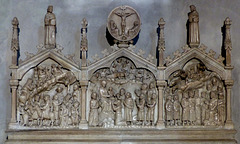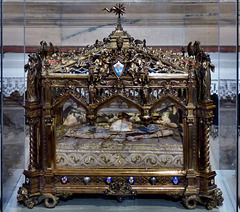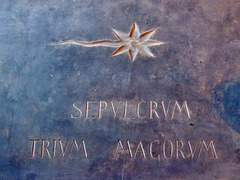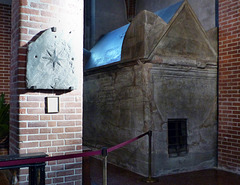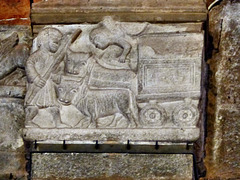Martin M. Miles' photos
Milan - Basilica of Sant'Ambrogio
| |
|
|
Milan is the city capital of the Lombardy and the second most populous city in Italy after Rome. Known during Roman times as "Mediolanum" it was the place, where in 313 Constantine I and Licinius met and "signed" the "Edict of Milan", giving Christianity a legal status within the Roman empire.
At the end of the Roman empire Milan was besieged by the Visigoths in 402, looted by the Huns in 452, and taken by the Ostrogoths in 539. Only 30 years later is belonged to the Kingdom of the Lombards, until in 774 Charlemagne defeated the Langobards and added Milan to the Carolingian empire. During Barbarossa´s (Frederik I) "Italian Campaigns" Milan was taken and destroyed to a great extent.
The "Basilica of Sant'Ambrogio" is much older and was not destroyed by Barbarossa´s troops. It is one of the most ancient churches in Milan, built by St. Ambrose in 379–386, outside the city of Milan on the site of a cemetery, where the martyrs of the Roman persecutions had been buried. The first name of the church was "Basilica Martyrum".
Ambrose, born into a noble family about 340 in (present-day) Trier (Germany), was governor of Liguria and Emilia for two years before he became the Bishop of Milan in 374 by popular acclamation. He was a staunch opponent of Arianism.
Only very few traces of the first church can still be found, as in the centuries after its construction, the basilica underwent numerous restorations and reconstructions. The current Romanesque church, mostly built in brickwork, was begun around 1080.
In 789, a Benedictine monastery was established here. The canons of the basilica, however, retained their own community. So two separate communities shared the basilica. In the 11th century, the canons adopted orders and became Canons Regular. From then on two separate monastic orders following different rules lived in the basilica. The canons were in the northern building, the cloister of the canons, while the monks were in the two southern buildings.
The two towers symbolize the division in the basilica. The 9th century Torre dei Monaci ("Tower of the Monks") tower was used by the monks. However, the canons did not have a bell tower and were not allowed to ring bells until they finished the Canons' bell tower in the 12th Century. This tower got two additional levels in 1889.
In 1943 the basilica got severely damaged by bombings. It took a decade to rebuilt and reconstruct the church.
The facade, seen from the atrium, where originally the catechumens gathered during the mass. As they were not yet baptized, they were not allowed to enter the basilica. When later infant baptism got more common the atrium was used as a gathering place for all pious citizens waiting to get a blessing from the Bishop.
Milan - Basilica of Sant'Ambrogio
| |
|
|
Milan is the city capital of the Lombardy and the second most populous city in Italy after Rome. Known during Roman times as "Mediolanum" it was the place, where in 313 Constantine I and Licinius met and "signed" the "Edict of Milan", giving Christianity a legal status within the Roman empire.
At the end of the Roman empire Milan was besieged by the Visigoths in 402, looted by the Huns in 452, and taken by the Ostrogoths in 539. Only 30 years later is belonged to the Kingdom of the Lombards, until in 774 Charlemagne defeated the Langobards and added Milan to the Carolingian empire. During Barbarossa´s (Frederik I) "Italian Campaigns" Milan was taken and destroyed to a great extent.
The "Basilica of Sant'Ambrogio" is much older and was not destroyed by Barbarossa´s troops. It is one of the most ancient churches in Milan, built by St. Ambrose in 379–386, outside the city of Milan on the site of a cemetery, where the martyrs of the Roman persecutions had been buried. The first name of the church was "Basilica Martyrum".
Ambrose, born into a noble family about 340 in (present-day) Trier (Germany), was governor of Liguria and Emilia for two years before he became the Bishop of Milan in 374 by popular acclamation. He was a staunch opponent of Arianism.
Only very few traces of the first church can still be found, as in the centuries after its construction, the basilica underwent numerous restorations and reconstructions. The current Romanesque church, mostly built in brickwork, was begun around 1080.
In 789, a Benedictine monastery was established here. The canons of the basilica, however, retained their own community. So two separate communities shared the basilica. In the 11th century, the canons adopted orders and became Canons Regular. From then on two separate monastic orders following different rules lived in the basilica. The canons were in the northern building, the cloister of the canons, while the monks were in the two southern buildings.
The two towers symbolize the division in the basilica. The 9th century Torre dei Monaci ("Tower of the Monks") tower was used by the monks. However, the canons did not have a bell tower and were not allowed to ring bells until they finished the Canons' bell tower in the 12th Century. This tower got two additional levels in 1889.
In 1943 the basilica got severely damaged by bombings. It took a decade to rebuilt and reconstruct the church.
Milan - San Babila
| |
|
|
Milan is the city capital of the Lombardy and the second most populous city in Italy after Rome. Known during Roman times as "Mediolanum" it was the place, where in 313 Constantine I and Licinius met and "signed" the "Edict of Milan", giving Christianity a legal status within the Roman empire.
At the end of the Roman empire Milan was besieged by the Visigoths in 402, looted by the Huns in 452, and taken by the Ostrogoths in 539. Only 30 years later is belonged to the Kingdom of the Lombards, until in 774 Charlemagne defeated the Langobards and added Milan to the Carolingian empire. During Barbarossa´s (Frederik I) "Italian Campaigns" Milan was taken and destroyed to a great extent.
The "Basilica di San Babila" was erected here, near the city walls, end of the 11th. The relics of Saint Babylas of Antioch had been brought to Milan already in the 5th century. The church got altered ane extended a couple of times and upto the late 19th century had a baroque façade.
Then renovations began intending to restore the appearance of the medieval basilica, and a Neo-Romanesque façade was built. The campanile was erected in the 1920s, replacing the original tower which collapsed in the 16th century.
Milan - Museo Diocesano
| |
|
|
Milan is the city capital of the Lombardy and the second most populous city in Italy after Rome. Known during Roman times as "Mediolanum" it was the place, where in 313 Constantine I and Licinius met and "signed" the "Edict of Milan", giving Christianity a legal status within the Roman empire.
At the end of the Roman empire Milan was besieged by the Visigoths in 402, looted by the Huns in 452, and taken by the Ostrogoths in 539. Only 30 years later is belonged to the Kingdom of the Lombards, until in 774 Charlemagne defeated the Langobards and added Milan to the Carolingian empire. During Barbarossa´s (Frederik I) "Italian Campaigns" Milan was taken and destroyed to a great extent.
The Basilica di Sant'Eustorgio, located only about 500 ms south of the Basilica di San Lorenzo, existed already since centuries at that time, as it was founded in the 4th century. The name refers to Eustorgius I, the bishop of Milan (~350).
It is attributed to Eustorgius to have translated the relics of the Magi to the city from Constantinople in 344, a present of Roman Emperor Constantius II (337-361). This legend came up in the 12th century, when the "new" Basilica di Sant'Eustorgio was erected in Romanesque style.
In 1164, when Milano was sacked by Frederick Barbarossa, Rainald von Dassel, who had just become Archbishop of Cologne and Archchancellor of Italy, he brought the bones of the Magi with him to Cologne as loot from Milan and as a gift of Emperor Frederick Barbarossa.
From the 13th century the church was the main Milanese seat of the Dominican Order, who promoted its rebuilding. The adjoining buildings, that once hosted the large convent are now home of the Museo Diocesano.
The stucco medaillon was one placed inside the basilica. Saint Ambrose (= Sant'Ambrogio) holds a book in his left and has his right arm in a blessing gesture. The inscription (book) SANC/TUS/AM/BRO/SIUS is dated to the 14th century, replacing an older one. The medaillon is probably from the 10th/11th century.
Milan - Museo Diocesano
| |
|
Milan is the city capital of the Lombardy and the second most populous city in Italy after Rome. Known during Roman times as "Mediolanum" it was the place, where in 313 Constantine I and Licinius met and "signed" the "Edict of Milan", giving Christianity a legal status within the Roman empire.
At the end of the Roman empire Milan was besieged by the Visigoths in 402, looted by the Huns in 452, and taken by the Ostrogoths in 539. Only 30 years later is belonged to the Kingdom of the Lombards, until in 774 Charlemagne defeated the Langobards and added Milan to the Carolingian empire. During Barbarossa´s (Frederik I) "Italian Campaigns" Milan was taken and destroyed to a great extent.
The Basilica di Sant'Eustorgio, located only about 500 ms south of the Basilica di San Lorenzo, existed already since centuries at that time, as it was founded in the 4th century. The name refers to Eustorgius I, the bishop of Milan (~350).
It is attributed to Eustorgius to have translated the relics of the Magi to the city from Constantinople in 344, a present of Roman Emperor Constantius II (337-361). This legend came up in the 12th century, when the "new" Basilica di Sant'Eustorgio was erected in Romanesque style.
In 1164, when Milano was sacked by Frederick Barbarossa, Rainald von Dassel, who had just become Archbishop of Cologne and Archchancellor of Italy, he brought the bones of the Magi with him to Cologne as loot from Milan and as a gift of Emperor Frederick Barbarossa.
From the 13th century the church was the main Milanese seat of the Dominican Order, who promoted its rebuilding. The adjoining buildings, that once hosted the large convent are now home of the Museo Diocesano.
Two liturgical vessels, created from gilded copper and enamel in Limoges. The "tower" is dated lat 12th, the dove early 13th century. Over centuries Limoges was the leading place for this kind of works.
Milan - Museo Diocesano
| |
|
Milan is the city capital of the Lombardy and the second most populous city in Italy after Rome. Known during Roman times as "Mediolanum" it was the place, where in 313 Constantine I and Licinius met and "signed" the "Edict of Milan", giving Christianity a legal status within the Roman empire.
At the end of the Roman empire Milan was besieged by the Visigoths in 402, looted by the Huns in 452, and taken by the Ostrogoths in 539. Only 30 years later is belonged to the Kingdom of the Lombards, until in 774 Charlemagne defeated the Langobards and added Milan to the Carolingian empire. During Barbarossa´s (Frederik I) "Italian Campaigns" Milan was taken and destroyed to a great extent.
The Basilica di Sant'Eustorgio, located only about 500 ms south of the Basilica di San Lorenzo, existed already since centuries at that time, as it was founded in the 4th century. The name refers to Eustorgius I, the bishop of Milan (~350).
It is attributed to Eustorgius to have translated the relics of the Magi to the city from Constantinople in 344, a present of Roman Emperor Constantius II (337-361). This legend came up in the 12th century, when the "new" Basilica di Sant'Eustorgio was erected in Romanesque style.
In 1164, when Milano was sacked by Frederick Barbarossa, Rainald von Dassel, who had just become Archbishop of Cologne and Archchancellor of Italy, he brought the bones of the Magi with him to Cologne as loot from Milan and as a gift of Emperor Frederick Barbarossa.
From the 13th century the church was the main Milanese seat of the Dominican Order, who promoted its rebuilding. The adjoining buildings, that once hosted the large convent are now home of the Museo Diocesano.
Milan - Basilica di Sant'Eustorgio
| |
|
|
|
Milan is the city capital of the Lombardy and the second most populous city in Italy after Rome. Known during Roman times as "Mediolanum" it was the place, where in 313 Constantine I and Licinius met and "signed" the "Edict of Milan", giving Christianity a legal status within the Roman empire.
At the end of the Roman empire Milan was besieged by the Visigoths in 402, looted by the Huns in 452, and taken by the Ostrogoths in 539. Only 30 years later is belonged to the Kingdom of the Lombards, until in 774 Charlemagne defeated the Langobards and added Milan to the Carolingian empire. During Barbarossa´s (Frederik I) "Italian Campaigns" Milan was taken and destroyed to a great extent.
Only a few large structures survived the fury. One of them was the Basilica di San Lorenzo (see previous uploads). The Basilica di Sant'Eustorgio, located only about 500 ms south of the Basilica di San Lorenzo, existed already since centuries at that time, as it was founded in the 4th century. The name refers to Eustorgius I, the bishop of Milan (~350).
It is attributed to Eustorgius to have translated the relics of the Magi to the city from Constantinople in 344, a present of Roman Emperor Constantius II (337-361). This legend came up in the 12th century, when the "new" Basilica di Sant'Eustorgio was erected in Romanesque style.
When Milano was sacked by Frederick Barbarossa, Rainald von Dassel, who had just become Archbishop of Cologne and Archchancellor of Italy, entered the Basilica. In 1164 he brought the bones of the Magi with him to Cologne as loot from Milan and as a gift of Emperor Frederick Barbarossa. Since then the relics are in the Cologne Cathedral, where they are kept in the "Shrine of the Three Kings".
The Portinari Chapel is located behind the apse at the eastern end of the Basilica. It was commisioned by Pigello Portinari, who was the representative in Milan of the Medici bank. The chapel was completed in 1468. In the center the elaborate marble sepulchre of Saint Peter of Verona (aka "Peter of Mailand"), commissioned in 1336 from Giovanni di Balduccio, who signed his work.
"Divine light" flows from the multi coloured dome over the sepulchre.
Saint Peter of Verona (= "Peter of Mailand") was a Dominican friar and a celebrated preacher, who served as Inquisitor in Lombardy. He was was killed in 1252 by an assassin, and ("sancto subito") was canonized 11 months after his death. This was the fastest canonization in history. Carino of Balsamo, Saint Peter´s murderer, later repented his sin and became a Dominican lay brother. He is a "beatus" is known as "Carino Pietro da Balsamo".
Peter of Verona was a very popular saint. The "St. Peter von Mailand-Bruderschaft" in Cologne was founded as the brewers´ guild in 1386 - and it still exists.
Milan - Basilica di Sant'Eustorgio
| |
|
Milan is the city capital of the Lombardy and the second most populous city in Italy after Rome. Known during Roman times as "Mediolanum" it was the place, where in 313 Constantine I and Licinius met and "signed" the "Edict of Milan", giving Christianity a legal status within the Roman empire.
At the end of the Roman empire Milan was besieged by the Visigoths in 402, looted by the Huns in 452, and taken by the Ostrogoths in 539. Only 30 years later is belonged to the Kingdom of the Lombards, until in 774 Charlemagne defeated the Langobards and added Milan to the Carolingian empire. During Barbarossa´s (Frederik I) "Italian Campaigns" Milan was taken and destroyed to a great extent.
Only a few large structures survived the fury. One of them was the Basilica di San Lorenzo (see previous uploads). The Basilica di Sant'Eustorgio, located only about 500 ms south of the Basilica di San Lorenzo, existed already since centuries at that time, as it was founded in the 4th century. The name refers to Eustorgius I, the bishop of Milan (~350).
It is attributed to Eustorgius to have translated the relics of the Magi to the city from Constantinople in 344, a present of Roman Emperor Constantius II (337-361). This legend came up in the 12th century, when the "new" Basilica di Sant'Eustorgio was erected in Romanesque style.
When Milano was sacked by Frederick Barbarossa, Rainald von Dassel, who had just become Archbishop of Cologne and Archchancellor of Italy, entered the Basilica. In 1164 he brought the bones of the Magi with him to Cologne as loot from Milan and as a gift of Emperor Frederick Barbarossa. Since then the relics are in the Cologne Cathedral, where they are kept in the "Shrine of the Three Kings".
The Portinari Chapel is located behind the apse at the eastern end of the Basilica. It was commisioned by Pigello Portinari, who was the representative in Milan of the Medici bank. The chapel was completed in 1468. In the center the elaborate marble sepulchre of Saint Peter of Verona (aka "Peter of Mailand"), commissioned in 1336 from Giovanni di Balduccio, who signed his work.
Here is the signature IOHANNES BALDUCCII DE PISIS
Saint Peter of Verona (= "Peter of Mailand") was a Dominican friar and a celebrated preacher, who served as Inquisitor in Lombardy. He was was killed in 1252 by an assassin, and ("sancto subito") was canonized 11 months after his death. This was the fastest canonization in history. Carino of Balsamo, Saint Peter´s murderer, later repented his sin and became a Dominican lay brother. He is a "beatus" is known as "Carino Pietro da Balsamo".
Peter of Verona was a very popular saint. The "St. Peter von Mailand-Bruderschaft" in Cologne was founded as the brewers´ guild in 1386 - and it still exists.
Milan - Basilica di Sant'Eustorgio
| |
|
|
|
Milan is the city capital of the Lombardy and the second most populous city in Italy after Rome. Known during Roman times as "Mediolanum" it was the place, where in 313 Constantine I and Licinius met and "signed" the "Edict of Milan", giving Christianity a legal status within the Roman empire.
At the end of the Roman empire Milan was besieged by the Visigoths in 402, looted by the Huns in 452, and taken by the Ostrogoths in 539. Only 30 years later is belonged to the Kingdom of the Lombards, until in 774 Charlemagne defeated the Langobards and added Milan to the Carolingian empire. During Barbarossa´s (Frederik I) "Italian Campaigns" Milan was taken and destroyed to a great extent.
Only a few large structures survived the fury. One of them was the Basilica di San Lorenzo (see previous uploads). The Basilica di Sant'Eustorgio, located only about 500 ms south of the Basilica di San Lorenzo, existed already since centuries at that time, as it was founded in the 4th century. The name refers to Eustorgius I, the bishop of Milan (~350).
It is attributed to Eustorgius to have translated the relics of the Magi to the city from Constantinople in 344, a present of Roman Emperor Constantius II (337-361). This legend came up in the 12th century, when the "new" Basilica di Sant'Eustorgio was erected in Romanesque style.
When Milano was sacked by Frederick Barbarossa, Rainald von Dassel, who had just become Archbishop of Cologne and Archchancellor of Italy, entered the Basilica. In 1164 he brought the bones of the Magi with him to Cologne as loot from Milan and as a gift of Emperor Frederick Barbarossa. Since then the relics are in the Cologne Cathedral, where they are kept in the "Shrine of the Three Kings".
The Portinari Chapel is located behind the apse at the eastern end of the Basilica. It was commisioned by Pigello Portinari, who was the representative in Milan of the Medici bank. The chapel was completed in 1468. In the center the elaborate marble sepulchre of Saint Peter of Verona (aka "Peter of Mailand"), commissioned in 1336 from Giovanni di Balduccio, who had in his younger years worked for Giovanni Pisano, and signed his work.
Saint Peter of Verona (= "Peter of Mailand") was a Dominican friar and a celebrated preacher, who served as Inquisitor in Lombardy. He was was killed in 1252 by an assassin, and ("sancto subito") was canonized 11 months after his death. This was the fastest canonization in history. Carino of Balsamo, Saint Peter´s murderer, later repented his sin and became a Dominican lay brother. He is a "beatus" is known as "Carino Pietro da Balsamo".
Peter of Verona was a very popular saint. The "St. Peter von Mailand-Bruderschaft" in Cologne was founded as the brewers´ guild in 1386 - and it still exists.
Of course Peter of Verona affected many miracles, some are seen here.
Milan - Basilica di Sant'Eustorgio
| |
|
Milan is the city capital of the Lombardy and the second most populous city in Italy after Rome. Known during Roman times as "Mediolanum" it was the place, where in 313 Constantine I and Licinius met and "signed" the "Edict of Milan", giving Christianity a legal status within the Roman empire.
At the end of the Roman empire Milan was besieged by the Visigoths in 402, looted by the Huns in 452, and taken by the Ostrogoths in 539. Only 30 years later is belonged to the Kingdom of the Lombards, until in 774 Charlemagne defeated the Langobards and added Milan to the Carolingian empire. During Barbarossa´s (Frederik I) "Italian Campaigns" Milan was taken and destroyed to a great extent.
Only a few large structures survived the fury. One of them was the Basilica di San Lorenzo (see previous uploads). The Basilica di Sant'Eustorgio, located only about 500 ms south of the Basilica di San Lorenzo, existed already since centuries at that time, as it was founded in the 4th century. The name refers to Eustorgius I, the bishop of Milan (~350).
It is attributed to Eustorgius to have translated the relics of the Magi to the city from Constantinople in 344, a present of Roman Emperor Constantius II (337-361). This legend came up in the 12th century, when the "new" Basilica di Sant'Eustorgio was erected in Romanesque style.
When Milano was sacked by Frederick Barbarossa, Rainald von Dassel, who had just become Archbishop of Cologne and Archchancellor of Italy, entered the Basilica. In 1164 he brought the bones of the Magi with him to Cologne as loot from Milan and as a gift of Emperor Frederick Barbarossa. Since then the relics are in the Cologne Cathedral, where they are kept in the "Shrine of the Three Kings".
The Portinari Chapel is located behind the apse at the eastern end of the Basilica. It was commisioned by Pigello Portinari, who was the representative in Milan of the Medici bank. The chapel was completed in 1468. In the center the elaborate marble sepulchre of Saint Peter of Verona (aka "Peter of Mailand"), commissioned in 1336 from Giovanni di Balduccio, who had in his younger years worked for Giovanni Pisano, and signed his work.
"Prudentia" is one of the virtues, that support the sepulchre.
Saint Peter of Verona (= "Peter of Mailand") was a Dominican friar and a celebrated preacher, who served as Inquisitor in Lombardy. He was was killed in 1252 by an assassin, and ("sancto subito") was canonized 11 months after his death. This was the fastest canonization in history. Carino of Balsamo, Saint Peter´s murderer, later repented his sin and became a Dominican lay brother. He is a "beatus" is known as "Carino Pietro da Balsamo".
Peter of Verona was a very popular saint. The "St. Peter von Mailand-Bruderschaft" in Cologne was founded as the brewers´ guild in 1386 - and it still exists.
Milan - Basilica di Sant'Eustorgio
| |
|
|
Milan is the city capital of the Lombardy and the second most populous city in Italy after Rome. Known during Roman times as "Mediolanum" it was the place, where in 313 Constantine I and Licinius met and "signed" the "Edict of Milan", giving Christianity a legal status within the Roman empire.
At the end of the Roman empire Milan was besieged by the Visigoths in 402, looted by the Huns in 452, and taken by the Ostrogoths in 539. Only 30 years later is belonged to the Kingdom of the Lombards, until in 774 Charlemagne defeated the Langobards and added Milan to the Carolingian empire. During Barbarossa´s (Frederik I) "Italian Campaigns" Milan was taken and destroyed to a great extent.
Only a few large structures survived the fury. One of them was the Basilica di San Lorenzo (see previous uploads). The Basilica di Sant'Eustorgio, located only about 500 ms south of the Basilica di San Lorenzo, existed already since centuries at that time, as it was founded in the 4th century. The name refers to Eustorgius I, the bishop of Milan (~350).
It is attributed to Eustorgius to have translated the relics of the Magi to the city from Constantinople in 344, a present of Roman Emperor Constantius II (337-361). This legend came up in the 12th century, when the "new" Basilica di Sant'Eustorgio was erected in Romanesque style.
When Milano was sacked by Frederick Barbarossa, Rainald von Dassel, who had just become Archbishop of Cologne and Archchancellor of Italy, entered the Basilica. In 1164 he brought the bones of the Magi with him to Cologne as loot from Milan and as a gift of Emperor Frederick Barbarossa. Since then the relics are in the Cologne Cathedral, where they are kept in the "Shrine of the Three Kings".
The Portinari Chapel is located behind the apse at the eastern end of the Basilica. It was commisioned by Pigello Portinari, who was the representative in Milan of the Medici bank. The chapel was completed in 1468. In the center the elaborate marble sepulchre of Saint Peter of Verona (aka "Peter of Mailand"), commissioned in 1336 from Giovanni di Balduccio, who had in his younger years workd for Giovanni Pisano, and signed his work.
Saint Peter of Verona (= "Peter of Mailand") was a Dominican friar and a celebrated preacher, who served as Inquisitor in Lombardy. He was was killed in 1252 by an assassin, and ("sancto subito") was canonized 11 months after his death. This was the fastest canonization in history. Carino of Balsamo, Saint Peter´s murderer, later repented his sin and became a Dominican lay brother. He is a "beatus" is known as "Carino Pietro da Balsamo".
Peter of Verona was a very popular saint. The "St. Peter von Mailand-Bruderschaft" in Cologne was founded as the brewers´ guild in 1386 - and it still exists.
Milan - Basilica di Sant'Eustorgio
| |
|
|
Milan is the city capital of the Lombardy and the second most populous city in Italy after Rome. Known during Roman times as "Mediolanum" it was the place, where in 313 Constantine I and Licinius met and "signed" the "Edict of Milan", giving Christianity a legal status within the Roman empire.
At the end of the Roman empire Milan was besieged by the Visigoths in 402, looted by the Huns in 452, and taken by the Ostrogoths in 539. Only 30 years later is belonged to the Kingdom of the Lombards, until in 774 Charlemagne defeated the Langobards and added Milan to the Carolingian empire. During Barbarossa´s (Frederik I) "Italian Campaigns" Milan was taken and destroyed to a great extent.
Only a few large structures survived the fury. One of them was the Basilica di San Lorenzo (see previous uploads). The Basilica di Sant'Eustorgio, located only about 500 ms south of the Basilica di San Lorenzo, existed already since centuries at that time, as it was founded in the 4th century. The name refers to Eustorgius I, the bishop of Milan (~350).
It is attributed to Eustorgius to have translated the relics of the Magi to the city from Constantinople in 344, a present of Roman Emperor Constantius II (337-361). This legend came up in the 12th century, when the "new" Basilica di Sant'Eustorgio was erected in Romanesque style.
When Milano was sacked by Frederick Barbarossa, Rainald von Dassel, who had just become Archbishop of Cologne and Archchancellor of Italy, entered the Basilica. In 1164 he brought the bones of the Magi with him to Cologne as loot from Milan and as a gift of Emperor Frederick Barbarossa. Since then the relics are in the Cologne Cathedral, where they are kept in the "Shrine of the Three Kings".
The Portinari Chapel is located behind the apse at the eastern end of the Basilica. It was commisioned by Pigello Portinari, who was the representative in Milan of the Medici bank. The chapel was completed in 1468. In the center the elaborate marble sepulchre of Saint Peter of Verona (aka "Peter of Mailand"), a Dominican friar and a celebrated preacher, who served as Inquisitor in Lombardy. He was was killed by an assassin, and ("sancto subito") was canonized 11 months after his death. This was the fastest canonization in history.
Peter of Verona was a very popular saint. The "St. Peter von Mailand-Bruderschaft" in Cologne was founded as the brewers´ guild in 1386 - and it still exists.
Milan - Basilica di Sant'Eustorgio
| |
|
|
Milan is the city capital of the Lombardy and the second most populous city in Italy after Rome. Known during Roman times as "Mediolanum" it was the place, where in 313 Constantine I and Licinius met and "signed" the "Edict of Milan", giving Christianity a legal status within the Roman empire.
At the end of the Roman empire Milan was besieged by the Visigoths in 402, looted by the Huns in 452, and taken by the Ostrogoths in 539. Only 30 years later is belonged to the Kingdom of the Lombards, until in 774 Charlemagne defeated the Langobards and added Milan to the Carolingian empire. During Barbarossa´s (Frederik I) "Italian Campaigns" Milan was taken and destroyed to a great extent.
Only a few large structures survived the fury. One of them was the Basilica di San Lorenzo (see previous uploads). The Basilica di Sant'Eustorgio, located only about 500 ms south of the Basilica di San Lorenzo, existed already since centuries at that time, as it was founded in the 4th century. The name refers to Eustorgius I, the bishop of Milan (~350).
It is attributed to Eustorgius to have translated the relics of the Magi to the city from Constantinople in 344, a present of Roman Emperor Constantius II (337-361). This legend came up in the 12th century, when the "new" Basilica di Sant'Eustorgio was erected in Romanesque style.
When Milano was sacked by Frederick Barbarossa, Rainald von Dassel, who had just become Archbishop of Cologne and Archchancellor of Italy, entered the Basilica. In 1164 he brought the bones of the Magi with him to Cologne as loot from Milan and as a gift of Emperor Frederick Barbarossa. Since then the relics are in the Cologne Cathedral, where they are kept in the "Shrine of the Three Kings".
The Portinari Chapel is located behind the apse at the eastern end of the Basilica. It was commisioned by Pigello Portinari, who was the representative in Milan of the Medici bank. The chapel was completed in 1468. In the center the elaborate marble sepulchre of Saint Peter of Verona (aka "Peter of Mailand"), a Dominican friar and a celebrated preacher, who served as Inquisitor in Lombardy. He was was killed by an assassin, and ("sancto subito") was canonized 11 months after his death. This was the fastest canonization in history.
Peter of Verona was a very popular saint. The "St. Peter von Mailand-Bruderschaft" in Cologne was founded as the brewers´ guild in 1386 - and it still exists.
Milan - Basilica di Sant'Eustorgio
| |
|
|
|
Milan is the city capital of the Lombardy and the second most populous city in Italy after Rome. Known during Roman times as "Mediolanum" it was the place, where in 313 Constantine I and Licinius met and "signed" the "Edict of Milan", giving Christianity a legal status within the Roman empire.
At the end of the Roman empire Milan was besieged by the Visigoths in 402, looted by the Huns in 452, and taken by the Ostrogoths in 539. Only 30 years later is belonged to the Kingdom of the Lombards, until in 774 Charlemagne defeated the Langobards and added Milan to the Carolingian empire. During Barbarossa´s (Frederik I) "Italian Campaigns" Milan was taken and destroyed to a great extent.
Only a few large structures survived the fury. One of them was the Basilica di San Lorenzo (see previous uploads). The Basilica di Sant'Eustorgio, located only about 500 ms south of the Basilica di San Lorenzo, existed already since centuries at that time, as it was founded in the 4th century. The name refers to Eustorgius I, the bishop of Milan (~350).
It is attributed to Eustorgius to have translated the relics of the Magi to the city from Constantinople in 344, a present of Roman Emperor Constantius II (337-361). This legend came up in the 12th century, when the "new" Basilica di Sant'Eustorgio was erected in Romanesque style.
When Milano was sacked by Frederick Barbarossa, Rainald von Dassel, who had just become Archbishop of Cologne and Archchancellor of Italy, entered the Basilica. In 1164 he brought the bones of the Magi with him to Cologne as loot from Milan and as a gift of Emperor Frederick Barbarossa. Since then the relics are in the Cologne Cathedral, where they are kept in the "Shrine of the Three Kings".
Of course the Magi were never forgotten in Milan and in 1903 some fragments of the holy bones were sent back from Cologne.
Here the Magi are seen in front of Herod´s throne (right), then the icon of the "Sleeping Magi" can be seen on the left. The Magi are not sleeping in a bed, but sitting on chairs. The Adoration is in the center - under ox, ass and an orchestra of angels. The altar is from 1347, attributed Jacopino da Tradate.
Milan - Basilica di Sant'Eustorgio
| |
|
|
Milan is the city capital of the Lombardy and the second most populous city in Italy after Rome. Known during Roman times as "Mediolanum" it was the place, where in 313 Constantine I and Licinius met and "signed" the "Edict of Milan", giving Christianity a legal status within the Roman empire.
At the end of the Roman empire Milan was besieged by the Visigoths in 402, looted by the Huns in 452, and taken by the Ostrogoths in 539. Only 30 years later is belonged to the Kingdom of the Lombards, until in 774 Charlemagne defeated the Langobards and added Milan to the Carolingian empire. During Barbarossa´s (Frederik I) "Italian Campaigns" Milan was taken and destroyed to a great extent.
Only a few large structures survived the fury. One of them was the Basilica di San Lorenzo (see previous uploads). The Basilica di Sant'Eustorgio, located only about 500 ms south of the Basilica di San Lorenzo, existed already since centuries at that time, as it was founded in the 4th century. The name refers to Eustorgius I, the bishop of Milan (~350).
It is attributed to Eustorgius to have translated the relics of the Magi to the city from Constantinople in 344, a present of Roman Emperor Constantius II (337-361). This legend came up in the 12th century, when the "new" Basilica di Sant'Eustorgio was erected in Romanesque style.
When Milano was sacked by Frederick Barbarossa, Rainald von Dassel, who had just become Archbishop of Cologne and Archchancellor of Italy, entered the Basilica. In 1164 he brought the bones of the Magi with him to Cologne as loot from Milan and as a gift of Emperor Frederick Barbarossa. Since then the relics are in the Cologne Cathedral, where they are kept in the "Shrine of the Three Kings".
Some fragments of the holy bones were sent back from Cologne to Milano in 1903, which are on display in this reliquary.
Milan - Basilica di Sant'Eustorgio
| |
|
Milan is the city capital of the Lombardy and the second most populous city in Italy after Rome. Known during Roman times as "Mediolanum" it was the place, where in 313 Constantine I and Licinius met and "signed" the "Edict of Milan", giving Christianity a legal status within the Roman empire.
At the end of the Roman empire Milan was besieged by the Visigoths in 402, looted by the Huns in 452, and taken by the Ostrogoths in 539. Only 30 years later is belonged to the Kingdom of the Lombards, until in 774 Charlemagne defeated the Langobards and added Milan to the Carolingian empire. During Barbarossa´s (Frederik I) "Italian Campaigns" Milan was taken and destroyed to a great extent.
Only a few large structures survived the fury. One of them was the Basilica di San Lorenzo (see previous uploads). The Basilica di Sant'Eustorgio, located only about 500 ms south of the Basilica di San Lorenzo, existed already since centuries at that time, as it was founded in the 4th century. The name refers to Eustorgius I, the bishop of Milan (~350).
It is attributed to Eustorgius to have translated the relics of the Magi to the city from Constantinople in 344, a present of Roman Emperor Constantius II (337-361). This legend came up in the 12th century, when the "new" Basilica di Sant'Eustorgio was erected in Romanesque style.
When Milano was sacked by Frederick Barbarossa, the relics of the Magi were appropriated and subsequently taken to Cologne by his close advisor Rainald of Dassel, Archbishop of Cologne. Actually the relics are still in the Cologne Cathedral, where the are kept in the "Shrine of the Three Kings". Some fragments of the holy bones were sent back from Cologne to Milano in 1903.
Milano had been a center of pilgrimage over a long time, but since 1164 the relics of the Magi attracted a stream of pilgrims to Cologne, what was very important for that city.
From the 13th century the church was the main Milanese seat of the Dominican Order, who promoted its rebuilding - and radically altered it with the construction of the south transept, the main crossings and within the 15th century by adding chapels (for noble families). The alterations of the 17th and 18th century were elimimnated by the restyling work of the 19th century "recreating" the original Lombard Romanesque forms.
A huge sarcophagus was the "home" of the Magi´s relics upto the day, when Rainald von Dassel, who had just become Archbishop of Cologne and Archchancellor of Italy, entered the Basilica. In 1164 he brought the bones of the Magi with him to Cologne as loot from Milan and as a gift of Emperor Frederick Barbarossa. Here is the inscription on the sarcophagus.
Milan - Basilica di Sant'Eustorgio
| |
|
Milan is the city capital of the Lombardy and the second most populous city in Italy after Rome. Known during Roman times as "Mediolanum" it was the place, where in 313 Constantine I and Licinius met and "signed" the "Edict of Milan", giving Christianity a legal status within the Roman empire.
At the end of the Roman empire Milan was besieged by the Visigoths in 402, looted by the Huns in 452, and taken by the Ostrogoths in 539. Only 30 years later is belonged to the Kingdom of the Lombards, until in 774 Charlemagne defeated the Langobards and added Milan to the Carolingian empire. During Barbarossa´s (Frederik I) "Italian Campaigns" Milan was taken and destroyed to a great extent.
Only a few large structures survived the fury. One of them was the Basilica di San Lorenzo (see previous uploads). The Basilica di Sant'Eustorgio, located only about 500 ms south of the Basilica di San Lorenzo, existed already since centuries at that time, as it was founded in the 4th century. The name refers to Eustorgius I, the bishop of Milan (~350).
It is attributed to Eustorgius to have translated the relics of the Magi to the city from Constantinople in 344, a present of Roman Emperor Constantius II (337-361). This legend came up in the 12th century, when the "new" Basilica di Sant'Eustorgio was erected in Romanesque style.
When Milano was sacked by Frederick Barbarossa, the relics of the Magi were appropriated and subsequently taken to Cologne by his close advisor Rainald of Dassel, Archbishop of Cologne. Actually the relics are still in the Cologne Cathedral, where the are kept in the "Shrine of the Three Kings". Some fragments of the holy bones were sent back from Cologne to Milano in 1903.
Milano had been a center of pilgrimage over a long time, but since 1164 the relics of the Magi attracted a stream of pilgrims to Cologne, what was very important for that city.
From the 13th century the church was the main Milanese seat of the Dominican Order, who promoted its rebuilding - and radically altered it with the construction of the south transept, the main crossings and within the 15th century by adding chapels (for noble families). The alterations of the 17th and 18th century were elimimnated by the restyling work of the 19th century "recreating" the original Lombard Romanesque forms.
This huge sarcophagus was the "home" of the Magi´s relics upto the day, when Rainald von Dassel, who had just become Archbishop of Cologne and Archchancellor of Italy, entered the Basilica. In 1164 he brought the bones of the Magi with him to Cologne as loot from Milan and as a gift of Emperor Frederick Barbarossa.
Milan - Basilica di Sant'Eustorgio
| |
|
Milan is the city capital of the Lombardy and the second most populous city in Italy after Rome. Known during Roman times as "Mediolanum" it was the place, where in 313 Constantine I and Licinius met and "signed" the "Edict of Milan", giving Christianity a legal status within the Roman empire.
At the end of the Roman empire Milan was besieged by the Visigoths in 402, looted by the Huns in 452, and taken by the Ostrogoths in 539. Only 30 years later is belonged to the Kingdom of the Lombards, until in 774 Charlemagne defeated the Langobards and added Milan to the Carolingian empire. During Barbarossa´s (Frederik I) "Italian Campaigns" Milan was taken and destroyed to a great extent.
Only a few large structures survived the fury. One of them was the Basilica di San Lorenzo (see previous uploads). The Basilica di Sant'Eustorgio, located only about 500 ms south of the Basilica di San Lorenzo, existed already since centuries at that time, as it was founded in the 4th century. The name refers to Eustorgius I, the bishop of Milan (~350).
It is attributed to Eustorgius to have translated the relics of the Magi to the city from Constantinople in 344, a present of Roman Emperor Constantius II (337-361). This legend came up in the 12th century, when the "new" Basilica di Sant'Eustorgio was erected in Romanesque style.
When Milano was sacked by Frederick Barbarossa, the relics of the Magi were appropriated and subsequently taken to Cologne by his close advisor Rainald of Dassel, Archbishop of Cologne. Actually the relics are still in the Cologne Cathedral, where the are kept in the "Shrine of the Three Kings". Some fragments of the holy bones were sent back from Cologne to Milano in 1903.
Milano had been a center of pilgrimage over a long time, but since 1164 the relics of the Magi attracted a stream of pilgrims to Cologne, what was very important for that city.
From the 13th century the church was the main Milanese seat of the Dominican Order, who promoted its rebuilding - and radically altered it with the construction of the south transept, the main crossings and within the 15th century by adding chapels (for noble families). The alterations of the 17th and 18th century were elimimnated by the restyling work of the 19th century "recreating" the original Lombard Romanesque forms.
Some of the old Romanesque capitals still exist. Seen here is probably the "translatio" of the Magi´s relics from Constantinople to Milano. I do not think this is the "translatio" from here to Cologne...
Jump to top
- ipernity © 2007-2024
- Help & Contact
|
Club news
|
About ipernity
|
History |
ipernity Club & Prices |
Guide of good conduct
Donate | Group guidelines | Privacy policy | Terms of use | Statutes | In memoria -
Facebook
Twitter

